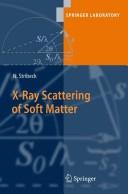| Listing 1 - 10 of 13 | << page >> |
Sort by
|
Book
ISBN: 1908979631 9781908979636 9781908979629 1908979623 Year: 2014 Publisher: London : Singapore : Imperial College Press, World Scientific,
Abstract | Keywords | Export | Availability | Bookmark
 Loading...
Loading...Choose an application
- Reference Manager
- EndNote
- RefWorks (Direct export to RefWorks)
This book highlights emerging diffraction studies of strain and dislocation gradients with mesoscale resolution, which is currently a focus of research at laboratories around the world. While ensemble-average diffraction techniques are mature, grain and subgrain level measurements needed to understand real materials are just emerging. In order to understand the diffraction signature of different defects, it is necessary to understand the distortions created by the defects and the corresponding changes in the reciprocal space of the non-ideal crystals. Starting with a review of defect classifications based on their displacement fields, this book then provides connections between different dislocation arrangements, including geometrically necessary and statistically stored dislocations, and other common defects and the corresponding changes in the reciprocal space and diffraction patterns. Subsequent chapters provide an overview of microdiffraction techniques developed during the last decade to extract information about strain and dislocation gradients. X-ray microdiffraction is a particularly exciting application compared with alternative probes of local crystalline structure, orientation and defect density, because it is inherently non-destructive and penetrating.
X-rays --- Diffraction --- Diffraction. --- Rayons X
Periodical
Abstract | Keywords | Export | Availability | Bookmark
 Loading...
Loading...Choose an application
- Reference Manager
- EndNote
- RefWorks (Direct export to RefWorks)
X-ray optics --- Roentgen optics --- X-ray optics. --- Physical optics --- Applied Physics --- Optique des rayons X

ISBN: 9780521826594 0521826594 9780511536281 9780521158060 0511168578 9780511168574 0511167539 9780511167539 051116808X 9780511168086 9780511169007 0511169000 0511536283 0521158060 1107146925 9781107146921 1280437200 9781280437205 9786610437207 6610437203 0511314507 9780511314506 Year: 2006 Volume: 39 Publisher: Cambridge : Cambridge University Press,
Abstract | Keywords | Export | Availability | Bookmark
 Loading...
Loading...Choose an application
- Reference Manager
- EndNote
- RefWorks (Direct export to RefWorks)
X-ray astronomy is the prime available window on astrophysical compact objects: black holes, neutron stars and white dwarfs. New observational opportunities have led to an explosion of knowledge in this field. This book provides a comprehensive overview of the astrophysics of compact objects that emit X-rays. Sixteen chapters written by the foremost experts in the field cover the observations and the astrophysical interpretation of these objects. Topics covered include binary systems, gamma ray burst sources, anomalous X-ray pulsars, super-soft sources, and enigmatic fast X-ray transients. Further chapters are dedicated to isolated neutron stars and the X-ray source populations of globular clusters. The properties of X-ray binaries are discussed in depth in chapters on quasi-periodic oscillations and related aperiodic X-ray variability, X-ray bursts, black holes, and relativistic jets. This is a valuable reference for both graduate students and active researchers.
X-ray astronomy --- Astronomie des rayons X --- X-ray astronomy. --- Astronomy. --- Astronomy --- Space astronomy --- X-rays

ISBN: 9781402035807 1402035802 9400790945 9786610411948 1280411945 1402035810 Year: 2005 Publisher: Dordrecht : Springer,
Abstract | Keywords | Export | Availability | Bookmark
 Loading...
Loading...Choose an application
- Reference Manager
- EndNote
- RefWorks (Direct export to RefWorks)
The application of X-rays to archaeological objects with the goal of gaining insight into both their construction and chemical composition, in a non-destructive manner, dates back to the discovery of radiation. Nowadays, X-ray techniques, such as X-ray fluorescense and diffraction are standard tools. This book offers physicists, art historians, archaeologists, curators, and conservators a detailed overview via contributions written by leading scientists in the field. The book contains scientific data, i.e. in situ measurement data taken with portable XRF and XRD, and fine data taken with accelerating ion beams and synchrotron radiations, together with their explanations. Results obtained by traditional scientific methods are also reviewed. The broad data collection spans experimental data taken both from monuments in the field and exhibits in museums, for example: ancient Egyptian wall-painting pigments ancient Egyptian wooden statues and mummies ancient Greek funerary monuments Cypriot ceramics medieval, Lyubliana and Venetian glass Romanian ceramics ancient Near-Eastern clay old Japanese porcelain pre-Hispanic items from America ancient Chinese underglaze-red blue and white porcelain Chinese celadon Phoenician cosmetics Also included are data from glazes, ancient gold and silver coins, gold jewelleries, gold alloys, corroded metals, gemstones (ruby, emerald and garnet), painting pigments, pottery, bronze, obsidian, stucco, turquoise, and so on. The discussion fostered here between natural scientists and archaeologists anticipates the future direction of archaeology.
X-ray spectroscopy in archaeology --- Archaeology --- X-rays --- Spectroscopie des rayons X en archéologie --- Archéologie --- Rayons X --- Congresses --- Methodology --- Congrès --- Méthodologie --- X-ray spectroscopy in archaeology - Congresses. --- History & Archaeology --- Spectroscopie des rayons X en archéologie --- Archéologie --- Congrès --- Méthodologie --- EPUB-LIV-FT LIVSOCIA SPRINGER-B --- Social sciences. --- Particle acceleration. --- Atomic structure. --- Molecular structure. --- Spectra. --- Crystallography. --- Archaeology. --- Social Sciences. --- Atomic/Molecular Structure and Spectra. --- Particle Acceleration and Detection, Beam Physics. --- Crystallography and Scattering Methods. --- Leptology --- Physical sciences --- Mineralogy --- Archeology --- Anthropology --- Auxiliary sciences of history --- History --- Antiquities --- Particles (Nuclear physics) --- Acceleration (Mechanics) --- Nuclear physics --- Acceleration --- Congresses. --- Atomic structure . --- Molecular structure . --- Structure, Molecular --- Chemical structure --- Structural bioinformatics --- Structure, Atomic --- Atomic theory
Periodical
ISSN: 00498246 10974539 Publisher: London
Abstract | Keywords | Export | Availability | Bookmark
 Loading...
Loading...Choose an application
- Reference Manager
- EndNote
- RefWorks (Direct export to RefWorks)
Spectrometric and optical chemical analysis --- fysicochemie --- Physics --- X-ray spectroscopy --- Spectroscopie des rayons X --- Periodicals --- Périodiques --- Röntgenstraling --- Spectrometrie --- #TS:TMTS --- Chemistry --- Chemical Engineering --- Physical Chemistry --- General and Others --- Spectrum analysis
Book
ISBN: 9780199228676 9780199228683 019922868X 0199228671 0191775118 0191004774 9780191004773 1299617069 9781299617063 Year: 2011 Publisher: Oxford University Press
Abstract | Keywords | Export | Availability | Bookmark
 Loading...
Loading...Choose an application
- Reference Manager
- EndNote
- RefWorks (Direct export to RefWorks)
The opportunities for doing scattering experiments at synchrotron and neutron facilities have grown rapidly in recent years and are set to continue to do so into the foreseeable future. This text provides a basic understanding of how these techniques enable the structure and dynamics of materials to be studied at the atomic and molecular level. Although mathematics cannot be avoided in a theoretical discussion, the aim has been to write a book that most scientists will still findapproachable. To this end, the first two chapters are devoted to providing a tutorial background in the mathematics
Neutrons --- X-rays --- Scattering. --- Rayons X --- Scattering --- Diffusion --- X-ray scattering --- Scattering (Physics) --- Nucleon-nucleon scattering --- Potential scattering --- scattering experiments, synchrotron facilities, neutron facilities, dynamics of materials, structure of materials
Periodical
ISSN: 00071285 1748880X Publisher: London : British institute of radiology,
Abstract | Keywords | Export | Availability | Bookmark
 Loading...
Loading...Choose an application
- Reference Manager
- EndNote
- RefWorks (Direct export to RefWorks)
The British Journal of Radiology is a multidisciplinary journal covering all clinical and technical aspects of diagnostic imaging, radiotherapy and oncology, medical physics and radiobiology. The multidisciplinary approach of the journal enables readers to keep up-to-date with developments in their own as well as related fields.
Physical methods for diagnosis --- Radiology. --- Radiology --- X-rays --- Radiologie --- Rayons X --- Periodicals. --- Périodiques --- X-rays. --- #TS:WDEP --- Periodicals --- Health Sciences --- Diagnostics --- Oncology --- Biophysics --- Radiation --- Life Sciences --- Physics --- General and Others --- Radiologic and Imaging Nursing --- Health Sciences. --- Radiation. --- Life Sciences. --- Physics. --- Rays, Roentgen --- Roentgen rays --- Roentgenograms --- Electromagnetic waves --- Ionizing radiation --- Cathode rays --- Radiography --- Vacuum-tubes --- Radiological physics --- Journal --- Medical radiology --- Health and Wellbeing.
Periodical
ISSN: 1724191X 11201797 Year: 1987 Publisher: [Amsterdam] : Elsevier
Abstract | Keywords | Export | Availability | Bookmark
 Loading...
Loading...Choose an application
- Reference Manager
- EndNote
- RefWorks (Direct export to RefWorks)
Biophysics --- Medical physics --- Imagerie médicale --- Radiothérapie --- Rayons X --- Physique --- Médecine --- Sécurité --- Mesures --- Mechanobiology --- Health physics --- Health radiation physics --- Medical radiation physics --- Radiotherapy physics --- Radiation therapy physics --- Physics --- Biophysics. --- Imaging systems in medicine --- Radiotherapy --- X-rays --- Medicine --- Physique médicale --- Biophysique --- Biophysique. --- Safety measures --- Radiotherapy. --- Physics. --- Medicine. --- Imaging systems in medicine. --- Medical physics. --- Safety measures.
Book
ISBN: 9780521814010 9781139525589 1139525581 9781139045872 1139045873 9781680156799 1680156799 9781139527972 1139527975 1139530259 9781139530255 0521814014 1139539604 1107225477 1283574713 9786613887160 1139526782 1139531441 9781139539609 9781107225473 9781283574716 6613887161 9781139526784 9781139531443 Year: 2012 Publisher: Cambridge : Cambridge University Press,
Abstract | Keywords | Export | Availability | Bookmark
 Loading...
Loading...Choose an application
- Reference Manager
- EndNote
- RefWorks (Direct export to RefWorks)
The availability of synchrotron x-ray sources and the subsequent developments described in this book have led to substantial progress in our understanding of molecular ordering at liquid interfaces. This practical guide enables graduate students and researchers working in physics, chemistry, biology and materials science to understand and carry out experimental investigations into the basic physical and chemical properties of liquid surfaces and interfaces. The book examines the surfaces of bulk liquids, thin wetting films and buried liquid-liquid interfaces. It discusses experiments on simple and complex fluids, including pure water and organic liquids, liquid crystals, liquid metals, electrified liquid-liquid interfaces and interfacial monolayers of amphiphiles, nanoparticles, polymers and biomolecules. A detailed description of the apparatus and techniques required for these experiments is provided, and theoretical approaches to data analysis are described, including approximate methods such as the Master formula, the Born approximation, Parratt's algorithm and the Distorted Wave Approximation.
Liquid-liquid interfaces --- Synchrotron radiation --- X-ray spectroscopy --- Interfaces liquide-liquide --- Rayonnement cyclotron --- Spectroscopie de rayons X --- Liquid-liquid interfaces. --- Synchrotron radiation. --- X-ray spectroscopy. --- Emission spectroscopy, X-ray --- Energy dispersive x-ray spectroscopy --- Excitation analysis, Fluorescent --- Fluorescence analysis, X-ray --- Fluorescent excitation analysis --- Fluorescent x-ray spectroscopy --- X-ray emission spectroscopy --- X-ray fluorescence analysis --- XES (X-ray emission spectroscopy) --- Spectrum analysis --- Bremsstrahlung, Magnetic --- Emission, Synchrotron --- Magnetic bremsstrahlung --- Synchrotron emission --- Electromagnetic waves --- Particles (Nuclear physics) --- Interfaces (Physical sciences)

ISBN: 9783540698555 3540698558 9786610863792 3540698566 128086379X Year: 2007 Publisher: Berlin ; New York : Springer,
Abstract | Keywords | Export | Availability | Bookmark
 Loading...
Loading...Choose an application
- Reference Manager
- EndNote
- RefWorks (Direct export to RefWorks)
Applications of X-ray scattering to soft matter have advanced considerably within recent years, both conceptually and technically – mature high-power X-ray sources, synchrotrons and rotating anodes, as well as high-speed detectors have become readily available. High-quality time-resolved experiments on polymer structure now can be performed with ease, a major advancement due to the genuine power of the scattering method. This manual summarizes the analytical power of modern X-ray scattering in the field of soft matter. Description of simple tools that can elucidate the mechanisms of structure evolution in the studied materials is followed by a step-by-step guide and breakdown of the more advanced methods. Data analysis based on clear, unequivocal results is rendered simple and straightforward – with a stress on the carefully planning of the experiments and adequate recording of all required data. To this end, this book serves as a useful ready-reference guide.
Soft condensed matter --- X-rays --- Matière molle (Physique) --- Rayons X --- Scattering --- Diffusion --- Soft condensed matter. --- Organic Chemistry --- Atomic Physics --- Physics --- Chemistry --- Physical Sciences & Mathematics --- Scattering. --- Matière molle (Physique) --- EPUB-LIV-FT LIVCHIMI SPRINGER-B --- X-ray scattering --- Chemistry. --- Physical chemistry. --- Polymers. --- Condensed matter. --- Amorphous substances. --- Complex fluids. --- Materials science. --- Polymer Sciences. --- Condensed Matter Physics. --- Characterization and Evaluation of Materials. --- Soft and Granular Matter, Complex Fluids and Microfluidics. --- Physical Chemistry. --- Scattering (Physics) --- Condensed matter --- Matter, Soft (Condensed matter) --- Matter, Soft condensed --- Soft matter (Condensed matter) --- Complex fluids
| Listing 1 - 10 of 13 | << page >> |
Sort by
|

 Search
Search Feedback
Feedback About UniCat
About UniCat  Help
Help News
News